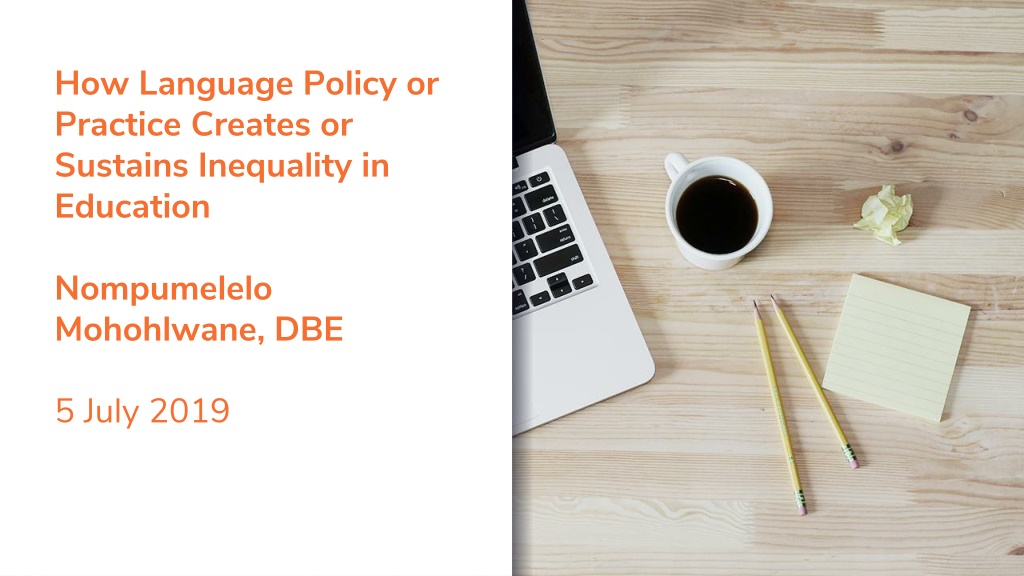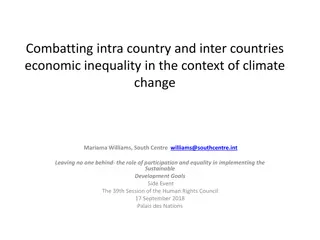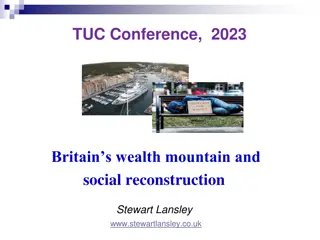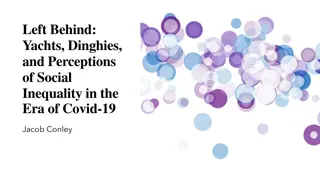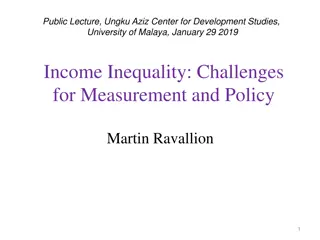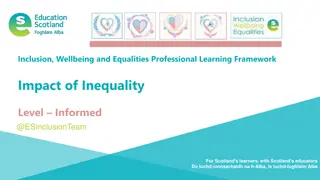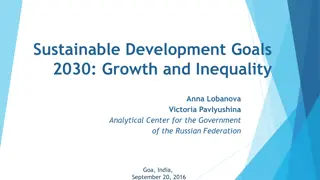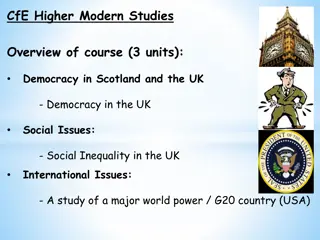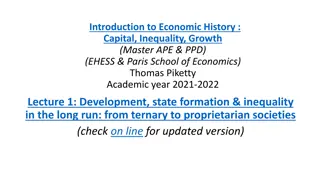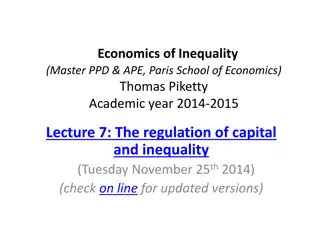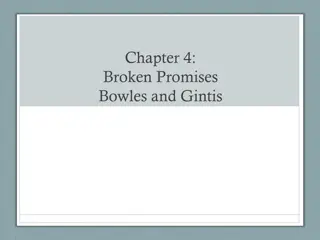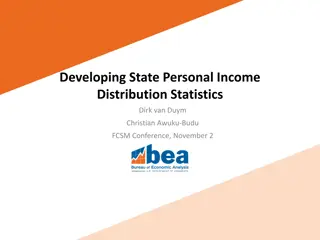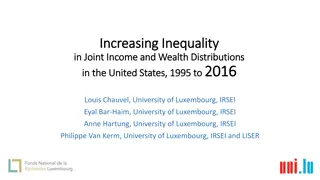Language Policy and Inequality in Education
Language policy and practice can either create or sustain inequalities in education, as illustrated by the development of Afrikaans and its impact on literacy achievement in South Africa. The deliberate shaping of language, such as the establishment of Afrikaans, reflects a historical context of power dynamics and social divisions. Understanding these complexities is crucial for addressing educational disparities and promoting inclusivity.
Download Presentation

Please find below an Image/Link to download the presentation.
The content on the website is provided AS IS for your information and personal use only. It may not be sold, licensed, or shared on other websites without obtaining consent from the author.If you encounter any issues during the download, it is possible that the publisher has removed the file from their server.
You are allowed to download the files provided on this website for personal or commercial use, subject to the condition that they are used lawfully. All files are the property of their respective owners.
The content on the website is provided AS IS for your information and personal use only. It may not be sold, licensed, or shared on other websites without obtaining consent from the author.
E N D
Presentation Transcript
How Language Policy or Practice Creates or Sustains Inequality in Education Nompumelelo Mohohlwane, DBE 5 July 2019
1. Language background Table of contents 2. Development of Afrikaans 3. Language planning 4. Language in Education Policy and Practice 5. Language and Power 2
Grade 4 PIRLS Literacy achievement by language of test Language English 23% isiZulu 22% isiXhosa 16% 81% of South Africa are racially classified as African 3
Southern Bantu language family in South Africa Sotho language family (disjunctive orthograhy) Northern Sotho Southern Sotho Setswana Nguni language family (Conjunctive orthography) isiZulu isiXhosa Siswati isiNdebele Non-clustered languages (Mainly disjunctive orthography) Tshivenda Xitsonga 4
Language does not develop incidentally, it is the product of deliberate efforts. The development of Afrikaans illustrates this 5
How did Afrikaans develop? Dutch European settlers Colonised or indented Khoi and San Afrikaans A doggerel poetry verse in 1795, Transcribed dialogue by a Dutch traveler in 1825, Letters to newspapers in 1830, Texts used in the mosque based on Arabic orthography within the Cape Muslim community Indo-Asian slaves mostly from Malaysia Enslaved Africans mostly from Angola 6
Specific establishment of Naspers to support Afrikaner nationalism How did Afrikaans develop? Die Burger daily newspaper edited by DF Malan later became Prime Minister in 1948 Genootskap van Regte Afrikaners (Society of True Afrikaners) with explicit to establishing Afrikaans as a language as an official language Society and politics Identified three types of Afrikaners, those with Afrikaans hearts, those with Dutch hearts and those with English hearts the Eerste Beginsels van die Afrikaans Taal (First Principles of the Afrikaans Language) Over time it printed more than 93,650 Dutch and 81,000 Afrikaans books. 7
How did Afrikaans develop? Jong Suid-Afrika (Young South Africa) which later became the Afrikaner Broederbond (Afrikaans brotherhood) Afrikaner nationalism, maintaining an Afrikaner culture, developing an Afrikaner economy, and gaining government. control of the South African Society and politics Federasie van Afrikaanse Kultuurvereniginge (FAK - Federation of Afrikaans Cultural Societie) Aim was to extend its influence and political activism while Broederbond focused on politics Clear that the establishment of Afrikaans was not only a linguistic effort but a cultural, societal, media under strong political leadership and processes 8
How did Afrikaans develop? First colonisation (Dutch) Introduction of Dutch then Afrikaans of official lang Second colonisation (British) English enforced as the official language Governance and Language Great Trek (Pretoria) Afrikaans as the official language Third colonisation (Apartheid) Afrikaans as official language 9
How did Afrikaans develop? 1961 Constitution no court of law shall be competent to enquire into or pronounce upon the validity of any Act passed by Parliament, other than an Act which repeals or amends the provisions of section 128 or 113 ... Education and law Afrikaans and English as a language of learning and teaching Afrikaner owned publishing houses principal providers of school textbooks. 1990-1998 (poetry, drama and fiction books) 2800 Afrikaans books, 970 were published in English and a total of 1200 were published across all 9 African languages 10
Theory of language planning 11
That language planning should serve so many covert goals is not surprising. Language is the fundamental institution of society, not only because it is the first human institution experienced by the individual, but also because all other institutions are built upon its regulatory patterns . . .To plan language is to plan society. (Cooper 1989: 182) 12
Language planning focuses on two aspects status planning and corpus planning with the aim of answering questions on: How did Afrikaans develop? Language purpose Language use Development in relation to education Relationship to economics Role of social integration Language planning Language planning application (Earman1983). 4 key components within languages: Fact-finding Establishing goals and strategies Implementation Evaluation. 13
Three customarily Afrikaans, East Afrikaans and Orange River Afrikaans basic varieties identified, of Afrikaans Cape namely, How did Afrikaans develop? Standardised Afrikaans is largely based on the East Afrikaans which is most similar to Dutch and was largely spoken by the Dutch Dutch European settlers Colonised or indented Khoi and San Afrikaans Standardisation included adopting Dutch language prestige norms Indo-Asian slaves mostly from Malaysia Enslaved Africans mostly from Angola Deliberate exclusionary privileged Afrikaner nationalism effort variant to create of a racially that Afrikaans Clear link to economic return for Afrikaners 14
4 criteria (Reagan) of good language policy: How did Afrikaans develop? Desirability: the community believe in the policy goal Justness: the policy is fair and equitable Effectiveness: the policy achieves its objectives Tolerability: the policy is resource-sensitive or viable within the context. Language planning Afrikaans succeeded against this criteria for some Afrikaans failed when extended to African people- 1975 Blacks are not dustbins - Afrikaans stinks 15
Language planning in democracy 16
Language in education policies guided primarily, by the rights and responsibilities in the Constitution of South Africa. How are languages developing now? Aims to serve to redress historical inequalities and future educational outcomes Recognizes 11 official languages and gives authority to provinces to use any of these languages for governance, with a minimum of two languages used. Constitution 1996 Specific mention for Khoi, Nama and San languages; and finally, Sign Language Establishes Pan South African Language Board (PANSALB) to promote and create conditions for the development and use of the official languages National and provincial government tasked with monitoring and regulating the use of languages 17
Continued Afrikaans dominance? How are languages developing now? Constitutional court affirmed 2016 University of Free State Senate decision to have the single medium of English as the language of instruction The university historically provided teaching in Afrikaans then adopted dual-medium provisioning in English and Afrikaans from 1993 Constitution 1996 University of Pretoria now English as the single medium University of Stellenbosch has adopted a dual-medium language policy of English and Afrikaans Social integration Social integration Development for education Development for education Relationship to economics 18
Fact-finding Establishing goals and strategies Implementation Evaluation Language planning gaps A lack of development of the African languages as academic languages; Translated curriculum statements in African languages Insufficient quantities of teacher with proficiency in effective teaching of African languages Social integration Development for education Social integration Development for education Relationship to economics Societal lack of the valuing of African languages Still need to transition to English and ensuring that adequate language development takes place in English to enable this Lack of an economic return for knowing African languages Lack of prioritised resources for language planning 19
Language in education policies 20
National Education Policy Act (NEPA) 1996 What are the education policies on language? Determination of national education policy by Minister of Education after consultation with provincial heads Function of the Minister as determining the language Functions of provinces as coordinating administrative actions and implement national policy South African Schools Act (SASA) 1996 Minister determines norms and standards for language policy in public schools. School Governing Bodies (SGBs) determine the language policy of the school 21
Norms and Standards for Language Policy in Public Schools 1997 What are the education policies on language? Learners may study in their Home Language from Grade 1-6 Additive multilingualism approach, where mastery of the Home Language arguably enables learning additional languages. Parental choice through school selection based on LOLT SGB determining school language policy but also promoting multilingualism Additional provisions: Need for research to continuously inform this policy Development of all 11 official languages Development of programmes for the redress of all African languages 22
Policy ambiguity Low High Low Administrative Experimental implementation implementation (planning and (context, variation, Level conflict resources) learning) High Political Symbolic implementation implementation (power and (local coalitions) feedback) 23
Policy ambiguity Low Administrative Implementation High Experimental implementation Low NEPA EGRS SASA Political implementation Symbolic implementation High Level conflict SASA Constitution Norms and Standards for Language Policy in Public Schools Norms and Standards for Language Policy in Public Schools BELA Bill University LOLT 24
